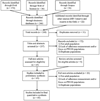A systematic review of antiretroviral adherence interventions for HIV-infected people who use drugs
- PMID: 22936463
- PMCID: PMC3495269
- DOI: 10.1007/s11904-012-0134-8
A systematic review of antiretroviral adherence interventions for HIV-infected people who use drugs
Abstract
HIV-infected persons who use drugs (PWUDs) are particularly vulnerable for suboptimal combination antiretroviral therapy (cART) adherence. A systematic review of interventions to improve cART adherence and virologic outcomes among HIV-infected PWUDs was conducted. Among the 45 eligible studies, randomized controlled trials suggested directly administered antiretroviral therapy, medication-assisted therapy (MAT), contingency management, and multi-component, nurse-delivered interventions provided significant improved short-term adherence and virologic outcomes, but these effects were not sustained after intervention cessation. Cohort and prospective studies suggested short-term increased cART adherence with MAT. More conclusive data regarding the efficacy on cART adherence and HIV treatment outcomes using cognitive behavioral therapy, motivational interviewing, peer-driven interventions and the integration of MAT into HIV clinical care are warranted. Of great concern was the virtual lack of interventions with sustained post-intervention adherence and virologic benefits. Future research directions, including the development of interventions that promote long-term improvements in adherence and virologic outcomes, are discussed.
Figures
References
-
- Egger M, May M, Chene G, Phillips AN, Ledergerber B, Dabis F, et al. Prognosis of HIV-1-infected patients starting highly active antiretroviral therapy: a collaborative analysis of prospective studies. Lancet. 2002;360(9327):119–129. - PubMed
-
- Gortmaker SL, Hughes M, Cervia J, Brady M, Johnson GM, Seage GR., 3rd Effect of combination therapy including protease inhibitors on mortality among children and adolescents infected with HIV-1. N Engl J Med. 2001;345(21):1522–1528. - PubMed
-
- Altice FL, Friedland GH. The era of adherence to HIV therapy. Ann Intern Med. 1998;129(6):503–505. - PubMed
Publication types
MeSH terms
Substances
Grants and funding
LinkOut - more resources
Full Text Sources
Medical


